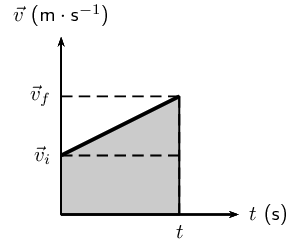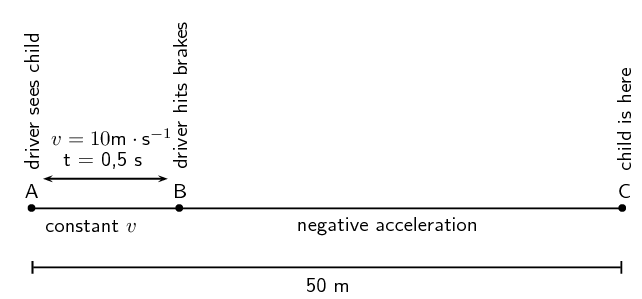A car starts off at \(\text{10}\) \(\text{m·s$^{-1}$}\) and accelerates at \(\text{1}\) \(\text{m·s$^{-2}$}\) for \(\text{10}\) \(\text{s}\). What is its final velocity?
21.7 Equations of motion
|
Previous
21.6 Description of motion
|
Next
Chapter summary
|
21.7 Equations of motion (ESAHG)
In this section we will look at the third way to describe motion. We have looked at describing motion in terms of words and graphs. In this section we examine equations that can be used to describe motion.
This section is about solving problems relating to uniformly accelerated motion. In other words, motion at constant acceleration.
The following are the variables that will be used in this section:
\begin{align*} \vec{v}_{i} & = \text{ initial velocity } \text{m·s$^{-1}$} \text{ at } t = \text{0}\text{ s} \\ \vec{v}_{f} & = \text{ final velocity } \text{m·s$^{-1}$} \text{ at time } t \\ \Delta \vec{x} & = \text{ displacement } \text{(m)} \\ t & = \text{ time } \text{s} \\ \Delta t & = \text{ time interval } \text{s} \\ \vec{a} & = \text{ acceleration } \text{m·s$^{-2}$} \end{align*}An alternate convention for some of the variables exists that you will likely encounter so here is a list for reference purposes:
\begin{align*} \vec{u} & = \text{ initial velocity } \text{m·s$^{-1}$} \text{ at } t = \text{0}\text{ s} \\ \vec{v} & = \text{ final velocity } \text{m·s$^{-1}$} \text{ at time } t \\ \vec{s} & = \text{ displacement } \text{(m)} \end{align*}Galileo Galilei of Pisa, Italy, was the first to determined the correct mathematical law for acceleration: the total distance covered, starting from rest, is proportional to the square of the time. He also concluded that objects retain their velocity unless a force – often friction – acts upon them, refuting the accepted Aristotelian hypothesis that objects “naturally” slow down and stop unless a force acts upon them. This principle was incorporated into Newton's laws of motion (1st law).
In this book we will use the first convention.
\begin{align*} {\vec{v}}_{f} & = {\vec{v}}_{i} + \vec{a}t \qquad (1) \\ \Delta \vec{x} & = \frac{\left({\vec{v}}_{i} + {\vec{v}}_{f}\right)}{2}t \qquad (2) \\ \Delta \vec{x} & = {\vec{v}}_{i}t + \frac{1}{2}\vec{a}{t}^{2} \qquad (3) \\ {v}_{f}^{2} & = {v}_{i}^{2} + 2\vec{a}\Delta \vec{x} \qquad (4) \end{align*}The questions can vary a lot, but the following method for answering them will always work. Use this when attempting a question that involves motion with constant acceleration. You need any three known quantities (\({\vec{v}}_{i}\), \({\vec{v}}_{f}\), \(\Delta \vec{x}\), \(t\) or \(\vec{a}\)) to be able to calculate the fourth one.
Problem solving strategy:
-
Read the question carefully to identify the quantities that are given. Write them down.
-
Identify the equation to use. Write it down!!!
-
Ensure that all the values are in the correct units and fill them in your equation.
-
Calculate the answer and check your units.
Worked example 7: Equations of motion
A racing car is travelling North. It accelerates uniformly covering a distance of \(\text{725}\) \(\text{m}\) in \(\text{10}\) \(\text{s}\). If it has an initial velocity of \(\text{10}\) \(\text{m·s$^{-1}$}\), find its acceleration.
Identify what information is given and what is asked for
We are given:
\begin{align*} {\vec{v}}_{i} & = \text{10}\text{ m·s$^{-1}$} \\ \Delta \vec{x} & = \text{725}\text{ m} \\ t & = \text{10}\text{ s} \\ \vec{a} & = ? \end{align*}Find an equation of motion relating the given information to the acceleration
If you struggle to find the correct equation, find the quantity that is not given and then look for an equation that has this quantity in it.
We can use
\[\Delta \vec{x} = {\vec{v}}_{i}t + \frac{1}{2}\vec{a}{t}^{2}\]Substitute your values in and find the answer
\begin{align*} \Delta \vec{x} & = {\vec{v}}_{i}t + \frac{1}{2}\vec{a}{t}^{2} \\ \text{725}\text{ m} & = \left(\text{10}\text{ m·s$^{-1}$} \times \text{10}\text{ s} \right) + \frac{1}{2} \vec{a} \times \left(\text{10}\text{ s}\right)^{2} \\ \text{725}\text{ m} - \text{100}\text{ m} & = \left(\text{50}\text{ s$^{2}$}\right)\vec{a} \\ \vec{a} & = \text{12,5}\text{ m·s$^{-2}$} \end{align*}Quote the final answer
The racing car is accelerating at \(\text{12,5}\) \(\text{m·s$^{-2}$}\) North.
Worked example 8: Equations of motion 1
A motorcycle, travelling East, starts from rest, moves in a straight line with a constant acceleration and covers a distance of \(\text{64}\) \(\text{m}\) in \(\text{4}\) \(\text{s}\). Calculate
-
its acceleration
-
its final velocity
-
at what time the motorcycle had covered half the total distance
-
what distance the motorcycle had covered in half the total time.
Identify what information is given and what is asked for
We are given:
\begin{align*} \vec{v}_{i} & = \text{0}\text{ m·s$^{-1}$} \text{ (because the object starts from rest)} \\ \Delta \vec{x} & = \text{64}\text{ m} \\ t & = \text{4}\text{ s} \\ \vec{a} & = ? \\ \vec{v}_{f} & = ? \\ t & = ? \text{ at half the distance } \Delta \vec{x} = \text{32}\text{ m} \\ \Delta \vec{x} & = ? \text{ at half the time } t \text{2}\text{ s} \end{align*}All quantities are in SI units.
Acceleration: Find a suitable equation to calculate the acceleration
We can use
\[\Delta \vec{x}={\vec{v}}_{i}t+\frac{1}{2}\vec{a}{t}^{2}\]Substitute the values and calculate the acceleration
\begin{align*} \Delta \vec{x} & = {\vec{v}}_{i}t+\frac{1}{2}\vec{a}{t}^{2} \\ \text{64}\text{ m} & = \left(\text{0}\text{ m·s$^{-1}$} \times \text{4}\text{ s}\right) + \frac{1}{2}\vec{a} \times (\text{4}\text{ s})^{2} \\ \text{64}\text{ m} & = \left(\text{8}\text{ s$^{2}$}\right) \vec{a} \\ \vec{a} & = \text{8}\text{ m·s$^{-2}$} \text{ East} \end{align*}Final velocity: Find a suitable equation to calculate the final velocity
We can use Equation 1 - remember we now also know the acceleration of the object.
\[{\vec{v}}_{f}={\vec{v}}_{i}+\vec{a}t\]Substitute the values and calculate the final velocity
\begin{align*} {\vec{v}}_{f} & = {\vec{v}}_{i} + at \\ {\vec{v}}_{f} & = \text{0}\text{ m·s$^{-1}$} + \left(\text{8}\text{ m·s$^{-2}$}\right)\left(\text{4}\text{ s}\right) \\ & = \text{32}\text{ m·s$^{-1}$} \text{ East} \end{align*}Time at half the distance: Find an equation to calculate the time
We can use Equation 3:
\begin{align*} \Delta \vec{x} & = {\vec{v}}_{i} + \frac{1}{2}\vec{a}{t}^{2} \\ \text{32}\text{ m} & = \left(\text{0}\text{ m·s$^{-1}$}\right)t + \frac{1}{2}\left(\text{8}\text{ m·s$^{-2}$}\right){\left(t\right)}^{2} \\ \text{32}\text{ m} & = 0 + \left(\text{4}\text{ m·s$^{-2}$}\right){t}^{2} \\ \text{8}\text{ s$^{2}$} & = {t}^{2} \\ t & = \text{2,83}\text{ s} \end{align*}Distance at half the time: Find an equation to relate the distance and time
Half the time is \(\text{2}\) \(\text{s}\), thus we have \({\vec{v}}_{i}\), \(\vec{a}\) and \(t\) all in the correct units. We can use Equation 3 to get the distance:
\begin{align*} \Delta \vec{x} & = {\vec{v}}_{i}t+\frac{1}{2}a{t}^{2} \\ & = \left(\text{0}\text{ m·s$^{-1}$}\right)\left(\text{2}\text{ s}\right) + \frac{1}{2}\left(\text{8}\text{ m·s$^{-2}$}\right){\left(\text{2}\text{ s}\right)}^{2} \\ & = \text{16}\text{ m} \text{ East} \end{align*}Equations of motion
A train starts from rest, and accelerates at \(\text{1}\) \(\text{m·s$^{-2}$}\) for \(\text{10}\) \(\text{s}\). How far does it move?
A bus is going \(\text{30}\) \(\text{m·s$^{-1}$}\) and stops in \(\text{5}\) \(\text{s}\). What is its stopping distance for this speed?
A racing car going at \(\text{20}\) \(\text{m·s$^{-1}$}\) stops in a distance of \(\text{20}\) \(\text{m}\). What is its acceleration?
A ball has a uniform acceleration of \(\text{4}\) \(\text{m·s$^{-2}$}\). Assume the ball starts from rest. Determine the velocity and displacement at the end of \(\text{10}\) \(\text{s}\).
A motorcycle has a uniform acceleration of \(\text{4}\) \(\text{m·s$^{-2}$}\). Assume the motorcycle has an initial velocity of \(\text{20}\) \(\text{m·s$^{-1}$}\). Determine the velocity and displacement at the end of \(\text{12}\) \(\text{s}\).
An aeroplane accelerates uniformly such that it goes from rest to \(\text{144}\) \(\text{m·hr$^{-1}$}\) in \(\text{8}\) \(\text{s}\). Calculate the acceleration required and the total distance that it has travelled in this time.
Extension: Finding the equations of motion (ESAHH)
The following does not form part of the syllabus and can be considered additional information.
Derivation of Equation 1
According to the definition of acceleration:
\[\vec{a}=\frac{\Delta \vec{v}}{t}\]where \(\Delta \vec{v}\) is the change in velocity, i.e. \(\Delta v={\vec{v}}_{f} - {\vec{v}}_{i}\). Thus we have
\begin{align*} \vec{a} & = \frac{{\vec{v}}_{f} - {\vec{v}}_{i}}{t} \\ {\vec{v}}_{f} & = {\vec{v}}_{i} + \vec{a}t \end{align*}Derivation of Equation 2
We have seen that displacement can be calculated from the area under a velocity vs. time graph. For uniformly accelerated motion the most complicated velocity vs. time graph we can have is a straight line. Look at the graph below - it represents an object with a starting velocity of \({\vec{v}}_{i}\), accelerating to a final velocity \({\vec{v}}_{f}\) over a total time t.

To calculate the final displacement we must calculate the area under the graph - this is just the area of the rectangle added to the area of the triangle. This portion of the graph has been shaded for clarity.
\begin{align*} {\text{Area}}_{△} & = \frac{1}{2} b\times h \\ & = \frac{1}{2} t \times \left({v}_{f} - {v}_{i}\right) \\ & = \frac{1}{2}{v}_{f}t - \frac{1}{2}{v}_{i}t \end{align*}\begin{align*} {\text{Area}}_{\square } & = l \times b \\ & = t\times {v}_{i} \\ & = {v}_{i}t \end{align*}\begin{align*} \text{Displacement } & = {\text{Area}}_{\square } + {\text{Area}}_{△} \\ \Delta \vec{x} & = {v}_{i}t + \frac{1}{2}{v}_{f}t - \frac{1}{2}{v}_{i}t \\ \Delta \vec{x} & = \frac{\left({v}_{i} + {v}_{f}\right)}{2}t \end{align*}Derivation of Equation 3
This equation is simply derived by eliminating the final velocity \({v}_{f}\) in Equation 2. Remembering from Equation 1 that
\[{\vec{v}}_{f} = {\vec{v}}_{i} + \vec{a}t\]then Equation 2 becomes
\begin{align*} \Delta \vec{x} & = \frac{{\vec{v}}_{i} + {\vec{v}}_{i} + \vec{a}t}{2}t \\ & = \frac{2{\vec{v}}_{i}t + \vec{a}{t}^{2}}{2} \\ \Delta \vec{x} & = {\vec{v}}_{i}t + \frac{1}{2}\vec{a}{t}^{2} \end{align*}Derivation of Equation 4
This equation is just derived by eliminating the time variable in the above equation. From Equation 1 we know
\[t = \frac{{\vec{v}}_{f} - {\vec{v}}_{i}}{a}\]Substituting this into Equation 3 gives
\begin{align*} \Delta \vec{x} & = {\vec{v}}_{i}\left(\frac{{\vec{v}}_{f} - {\vec{v}}_{i}}{a}\right) + \frac{1}{2}a{\left(\frac{{\vec{v}}_{f} - {\vec{v}}_{i}}{\vec{a}}\right)}^{2} \\ & = \frac{{\vec{v}}_{i}{\vec{v}}_{f}}{\vec{a}} - \frac{{\vec{v}}_{i}^{2}}{\vec{a}} + \frac{1}{2}\vec{a}\left(\frac{{\vec{v}}_{f}^{2} - 2{\vec{v}}_{i}{\vec{v}}_{f} + {\vec{v}}_{i}^{2}}{{\vec{a}}^{2}}\right) \\ & = \frac{{\vec{v}}_{i}{\vec{v}}_{f}}{\vec{a}} - \frac{{\vec{v}}_{i}^{2}}{\vec{a}} + \frac{{\vec{v}}_{f}^{2}}{2\vec{a}} - \frac{{\vec{v}}_{i}{\vec{v}}_{f}}{\vec{a}} + \frac{{\vec{v}}_{i}^{2}}{2\vec{a}} \\ 2\vec{a}\Delta \vec{x} & = -2{\vec{v}}_{i}^{2} + {\vec{v}}_{f}^{2} + {\vec{v}}_{i}^{2} \\ {\vec{v}}_{f}^{2} & = {\vec{v}}_{i}^{2} + 2\vec{a}\Delta \vec{x} \end{align*}This gives us the final velocity in terms of the initial velocity, acceleration and displacement and is independent of the time variable.
Applications in the real-world (ESAHI)
What we have learnt in this chapter can be directly applied to road safety. We can analyse the relationship between speed and stopping distance. The following worked example illustrates this application.
Worked example 9: Stopping distance
A truck is travelling at a constant velocity of \(\text{10}\) \(\text{m·s$^{-1}$}\) when the driver sees a child \(\text{50}\) \(\text{m}\) in front of him in the road. He hits the brakes to stop the truck. The truck accelerates at a rate of \(-\text{1,25}\) \(\text{m·s$^{-2}$}\). His reaction time to hit the brakes is \(\text{0,5}\) seconds. Will the truck hit the child?
Analyse the problem and identify what information is given
It is useful to draw a time-line like this one:

We need to know the following:
-
What distance the driver covers before hitting the brakes.
-
How long it takes the truck to stop after hitting the brakes.
-
What total distance the truck covers to stop.
Calculate the distance \(AB\)
Before the driver hits the brakes, the truck is travelling at constant velocity. There is no acceleration and therefore the equations of motion are not used. To find the distance travelled, we use:
\begin{align*} v & = \frac{D}{t} \\ 10 & = \frac{D}{\text{0,5}} \\ D & = \text{5}\text{ m} \end{align*}The truck covers \(\text{5}\) \(\text{m}\) before the driver hits the brakes.
Calculate the time \(BC\)
We have the following for the motion between \(B\) and \(C\):
\begin{align*} {\vec{v}}_{i} & = \text{10}\text{ m·s$^{-1}$} \\ {\vec{v}}_{f} & = \text{0}\text{ m·s$^{-1}$} \\ a & = -\text{1,25}\text{ m·s$^{-2}$} \\ t & = ? \end{align*}We can use Equation 1:
\begin{align*} {\vec{v}}_{f} & = {\vec{v}}_{i} + at \\ 0 & = \text{10}\text{ m·s$^{-1}$} + \left(-\text{1,25}\text{ m·s$^{-2}$}\right)t \\ -\text{10}\text{ m·s$^{-1}$} & = \left(-\text{1,25}\text{ m·s$^{-2}$}\right)t \\ t & = \text{8}\text{ s} \end{align*}Calculate the distance \(BC\)
For the distance we can use Equation 2 or Equation 3. We will use Equation 2:
\begin{align*} \Delta \vec{x} & = \frac{\left({\vec{v}}_{i} + {\vec{v}}_{f}\right)}{2}t \\ \Delta \vec{x} & = \frac{10 + 0}{2} \left(8\right) \\ \Delta \vec{x} & = \text{40}\text{ m} \end{align*}Write the final answer
The total distance that the truck covers is \({d}_{AB} + {d}_{BC} = \text{5} + \text{40} = \text{45}\) meters. The child is \(\text{50}\) meters ahead. The truck will not hit the child.
|
Previous
21.6 Description of motion
|
Table of Contents |
Next
Chapter summary
|
